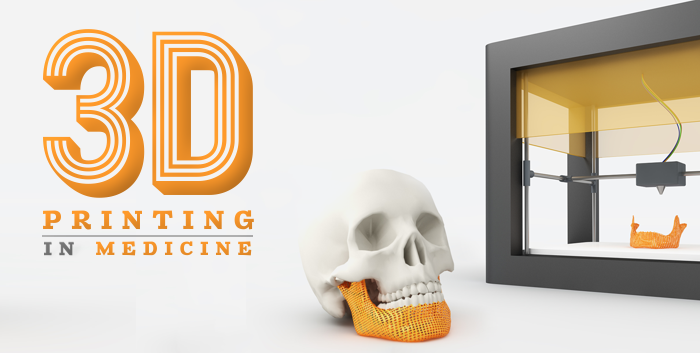It’s hard to believe but 3D-printing has been around since the mid-80s. Since then, we’ve seen all manner of things like pens, shoes, jewelry, and even cars, printed “out of thin air”.
Perhaps the most exciting use of this technology can be seen in the healthcare industry, and as the technology advances and becomes more accessible, we will see even more uses for it.
Driving Down the Cost of Healthcare
Normally, medical technologies are expensive when they enter the market but then become cheaper over time. However, a majority of 3D-printers are coming to the market at very reasonable prices. This has the potential to significantly drive down rising healthcare costs, and that too just in the nick of time, as more Baby Boomers will flood the system at alarming rates.
It’s the technology behind 3D-printing that makes the solutions so cost-effective. Essentially, objects are built from digital models using additive processes, where successive layers of material are laid on top of one another. Since objects can be assembled directly from digital models, precision increases significantly, removing room for error.
Consider the older manufacturing techniques that relied on taking away material (cutting, chopping, drilling) to make an object’s model instead of adding material like 3D-printing. These waste and extraction costs add up, and those expenses get passed on to consumers. But 3D-printing can get around all of that.
3D-Printing and Replacing Body Parts
A game poster for the 1970 TV series “The Six Million Dollar Man” illustrating bionic legs being surgically transplanted in the protagonist’s body.
“The 6 Million Dollar Man” and “The Bionic Woman” were very successful TV series in the 1970s about physically broken people who were fixed by advanced technology. Bionic legs allowed these otherwise ordinary humans, run faster and jump higher. Bionic eyes let them see farther, and bionic ears gave them extraordinary hearing.
What was once science fiction, is now becoming a reality thanks to 3D-printing technology. Scientists at Princeton University have used the technology to create a bionic ear that will allow people to hear radio frequencies far beyond the range of normal human hearing.
Through cybernetics, science is looking for ways to create customized replacement parts that contain capabilities beyond what human biology can provide. And, whether printed parts like kidneys and lungs offer regular or superior performance capabilities, this technology could someday eliminate the long wait time associated with organ donor lists, thereby saving countless lives.
3D-Printing and Surgery
Keith Londsdale, 74 receives a brand new 3D printed face from his son after eye cancer eats away his own.
3D bio printing is also becoming commonplace in the operating room, particularly when it comes to cancer treatments. For instance, in 2014, scientists developed a quick and inexpensive way to create facial prosthesis, for patients who had undergone surgery for eye cancer, using facial scanning software and 3D-printing.
In 2015, a group of researchers discovered that it is entirely possible to print patient-specific biodegradable implants that are more effective at curing bone infections and bone cancer.
These are staggering advances in 3D-printing technology, and we will no doubt see more in the OR that will bring science fiction into mainstream medicine.
Here are some other ways 3D-printing is changing the landscape of medicine:
Affordable Prosthetics
Physically unique members of society can easily obtain much less expensive and quicker prosthetics by way of 3D printing.
The cost of traditional prosthetics is a significant barrier to those without the proper resources. But 3D-printing is bringing hope and mobility to thousands, by making production relatively cheap.
Researchers are now able to produce cheap and easily customizable prosthetic sockets for people in third-world nations, where the destruction of war has left many with amputated limbs. Once locals are trained on how to operate the technology, they can create patient-specific limbs quickly and easily.
Print Prescription Drugs at Home
3-D printers can now make pills that deliver a customized dose of medicine.
Scientists at the University of Glasgow have been busy making a prototype 3D printer that would be capable of assembling chemical compounds at the molecular level. This means that someday a patient could go to an online drugstore with a digital prescription, buy the blueprint and chemical ink they need, and print their drugs at home.
Synthetic Skin
3D-Printed human skin could revolutionize medicine and cosmetics. French cosmetics firm L’Oréal is teaming up with bio-engineering start-up Organovo to 3D-print human skin.
James Yoo at the Wake Forest School of Medicine has developed a printer that can print skin straight onto the wounds of burn victims. Wounds are first scanned, then the printer fabricates the right number of skin layers to fill it in. Currently, the United States army is funding use of Yoo’s technology to treat wounded soldiers.
Medical Equipment
Medical devices produced by additive manufacturing include orthopedic and cranial implants, surgical instruments, dental restorations such as crowns, and external prosthetics.
As previously mentioned, 3D-printing is making a positive impact in poverty-stricken areas of the world because it provides health solutions, like customizable prosthetics, at a fraction of the price.
Another area where the technology is being used is in the affordable creation of medical equipment. For instance, the group iLab has brought 3D-printing to Haiti where it is used to make umbilical cord clamps for the local hospitals. In the future we may see these printers create bandages, catheters and endoscopes as well.
3D-printing is revolutionizing every facet of medicine, and how care can be delivered. Thanks to this constantly-advancing technology, medicine is becoming more available and affordable, and countless lives are being saved.

Join the Discussion!